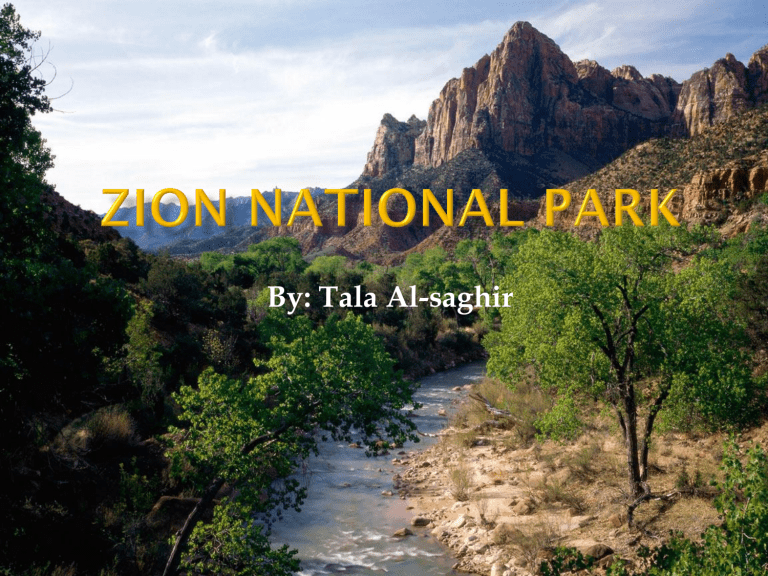Zion National Park Final Power Point

By: Tala Al-saghir
Zion National Park became established in the year of 1909 by President William Howard Taft, as Mukuntuweap
National Park. But in the year 1918 “the locally unpopular name” was changed to Zion National Park.
President William Taft
Zion National Park was established so its land and nature could be preserved forever. This way people from all generations and from all around the world could come and enjoy themselves and marvel at Zion’s natural beauty. Not only was it dedicated for people’s enjoyment, but also for their beneficence. People will be able to go, study, and learn new facts from Zion’s geography and inhabitations forever.
The Narrows
Over the past million years Zion National Park’s rocks have gone through four main geological formations. They have gone through sedimentation, lithification, uplift, and erosion. And throughout the years these four main actions many beautiful and amazing land forms and features have been created.
Zion Park use to be a very flat basin that was near sea. Over the years many sands, gravels, and mud eroded from the mountains nearby. Streams carried them into the basin and they were deposited in layers. Over these layers started adding up. And they became very heavy. This caused the basin to sink, so the top level always stayed near sea level. This action of sedimentation kept repeating until over 10,000 feet of sand, gravel and mud layers gathered and collected.
Over time water started to slowly filter through the very packed down sediments. When iron oxide, calcium carbonate, and silica started to filter through the sediments it started “cementing” them.
With the added pressure from layers of sediments over a very long time it was transformed into stone. Very old seabed’s transformed into limestone, mud and clay transformed into mudstone and shale, and desert sand became sandstone.
From deep inside the earth, something began to push to the surface. It was a very slow vertical hoisting of very big chunks of the crust. The elevation of Zion started to slowly uplift from about sea level to as high as 10,000 feet over sea level. The uplift is still going on right now to this day.
Over time streams got a much greater and stronger speed on their way down to the sea. This caused the streams to sharply fall off the plateau. Since the water was going so fast it carried a lot of sediment and very big boulders on its way. These streams started to erode the layers of rock and they formed many deep canyons. It has also collapsed layers of sediment causing the canyons to become even wider.
Throughout all these actions new lakes, canyons, and valleys have been created. And the key to all these changes is water. Water from springs, streams, and rivers has created what is now the canyons, mesas, cliffs, and valleys we see today. Without water Zion
National Park wouldn’t be what it is today.
Many different types of rocks can be found in Zion
National Park. Over millions of years Calcium Carbonate cemented all the loose grains of sand, and it made sedimentary rock. This sedimentary rock is very solid sandstone. Calcium
Carbonate also transformed the seabed into limestone.
And the mud and clay turned to mudstone and shale.
Limestone
Sandstone
The most famous feature in
Zion is the Great White Throne that towers 2,400 feet up in the air.
It’s second most famous feature is
The Checkerboard Mesa. Another one of its feature’s is its free standing arches. There are two main arches that mainly stand out;
The Crawford Arch and Kolob
Arch. Another amazing and fascinating feature is The Grand
Staircase. It is a bunch of colorful cliffs that are set between Bryce
Canyon and The Grand Canyon .
Great White Throne
The Checkerboard Mesa
You can also find the
Cathedral Mountain, The
Temple of Sinawava, The East and West rims, Angel Landing,
Emerald Pools, and The Altar of
Sacrifice. The Three Patriarchs are also another amazing land feature in Zion Park. The Three
Patriarchs are a trio of cliffs that are named Abraham, Isaac, and
Jacob. One of the best trails in all of the United States is the Zion
Narrow. And The Weeping
Rock Trail and The Riverside
Walk are also hiked a lot.
Angles Landing
The land in Zion National
Park, till now, is still slowly uplifting. Big blocks of its crust are being moved vertically over millions of years. The rock formations in Zion National park are also still changing. Over a large time period, the huge and grand monoliths that are in the
Park will return to being the sand dunes that they once where. The layers of sedimentary rock will be reduced to nothing but layers of sand. This is caused by weather and erosion.
One of them main environmental issues in Zion is
“automobile congestion”. Over two million people visit Zion
National Park every year. And on a typical summer day 4,000 to 5,000 vehicles go in and out of the park.
In Zion Canyon there are only 400 parking spaces, while about 2,000 cars drive up there each day.
Another issue is “noise pollution”.
So many cars drive up to Zion
Canyon, the sound of the cars echoes off of the canyon walls. And that really disrupts the calming effect of Zion National Park.
Human waste and litter are another concern. People who don’t throw away their trash, are not helping to conserve the natural and cultural resources. Vegetation near the roads and trails is also being damaged. This is happening because people, occasionally, do not stay on the marked trails. And over time it can lead to less vegetation, less soil compaction, and erosion. And it also causes ugly marks on the landscaping of the park.
Pine Creek Bridge is one of their best engineered bridges in
Zion National Park. It was built entirely out of Navajo
Sandstone and has a cemented rubble stone core. It was put there so people could cross over Pine Creek and while not ruining the landscape. The park has also put up recycling bins.
It helps by keeping the park clean. And while the park benefits from them it also helps out the environment.
Pine Creek Bridge
This map includes and identifies all of the important landforms and features in Zion
National park
Websites:
1.
2.
3.
4.
Uhler, John Willian. "Geology." Zion National Park Information. Hill
Climb Media. Web. http://www.zion.national-park.com/
Zion. 1994 InfoWest. Web. http://www.infowest.com/Utah/colorcountry/Nationalparks/Zio n/profile.html
"Geologic Formations." National Park Service US Department of the
Interior. Web. http://www.nps.gov/zion/naturescience/geologicformations.htm
"Zion National Park." Zion National Park. Web. http://www.gorp.com/parks-guide/travel-ta-zion-national-parkenvironment-sidwcmdev_067618.html
Newspaper:
1.
National Park Service U.S Department of the Interior. "Leave No
Trace." Zion National Park Map and Guide, Spring 2010 ed.: 1-12.
Print.
Encyclopedia:
1.
MLA (Modern Language Association) Style: "Zion National
Park." Encyclopedia Americana. 2010. Grolier Online. 9 May. 2010
. Chicago Manual of Style: "Zion National Park." Encyclopedia
Americana. Grolier Online
Http://ea.grolier.com/article?id=0430240-00 (accessed May 9,
2010). APA (American Psychological Association) Style: Zion
National Park. (2010). Encyclopedia Americana. Retrieved May 9,
2010, from Grolier Online
Http://ea.grolier.com/article?id=0430240-00







